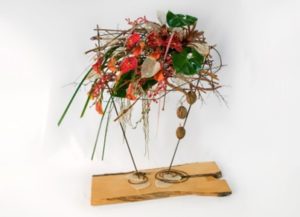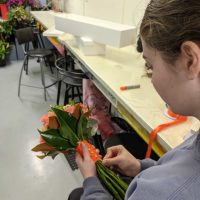[et_pb_section fb_built=”1″ _builder_version=”4.0.7″][et_pb_row column_structure=”2_3,1_3″ _builder_version=”4.0.7″][et_pb_column type=”2_3″ _builder_version=”4.0.7″][et_pb_post_title author=”off” date=”off” comments=”off” _builder_version=”4.0.7″ global_module=”1053″ saved_tabs=”all”][/et_pb_post_title][et_pb_text _builder_version=”4.0.7″ hover_enabled=”0″]
Do you really know the running temperature of your cool room?
It is interesting to ask a florist what temperature their cool room or refrigerated display cabinet operates at. Many are unsure, yet if the temperature is too cold the flowers’ life span is severely affected. In this article I will use the term ‘cool room’ referring to either a refrigerated display cabinet or a cool room. Some florists run cool rooms at considerable cost to the business when their incorrect use is actually damaging their stocks lifespan. A strong turnover of cut flowers can negate the need for a cool room at all.
A good florist will know exactly what temperature the cool room should be set to, depending on the flowers they place into it. Generally a cool room is set at six to eight degrees Celsius. Two to four degrees Celsius is too cold for most flowers as they will “shock” when removed from the cool room. Australia’s largest rose grower operates their cool room for roses at 7 degrees Celsius.
Do you need a cool room?
Firstly, consider the stock you are purchasing. As a florist, regardless of how quickly you sell and replenish your stock it is absolutely essential that you identify the quality of the stock that you are buying. You should ask the grower or dealer when the flowers were picked and examine the product to ensure it is fresh and healthy. Secondly, in retail florist shops, it is best to keep flowers at room temperature if possible. Flowers will acclimatize and handle delivery, as well as weather exposure, better if they haven’t been refrigerated. Florists should aim to turn over their perishable stock rather than keeping stock in a cool room for extended periods. The cooling process slows respiration and it can create a false illusion of how fresh the stock actually is. Flowers that remain in a cool room too long can look great to a buyer when they are first taken out of a cool room but their life span can be severely affected once they are taken home. In cooler climates generally there is no need to run a cool room for six months of the year. In warmer climates cool rooms may be needed but, if they are run too cold, the business deprives their client of the longevity of the blooms.
Regular readers of this column would be aware that I can draw on one hundred years of family floristry experience. In the past florists cool rooms were only used for funeral work as flowers were wired (pre water absorbent bases) and city and suburban florists would aim at selling out by the end of the day. All flowers were at room temperature. Alternatively, growers rarely refrigerated their flowers unless there was a shortage. They could use ‘storage’ of flowers. If you considered gladioli or stock, for example, they can be dry stored in a cool room set at two degrees Celsius. They are stored out of water. The flowers can be stored for a few days or a few weeks and the result is that their development is essentially stunted so that when they are removed from storage they look exactly as they would if they were freshly cut. Most retail florists do not ‘store’ flowers. Be careful of books or web sites that refer to storage as some florists confuse this process and set their cool room temperature too low.
Did you know that the recommended temperature for hospitals Australia wide is 27 degrees Celsius? Now consider a florist that removes flowers from a cool room set at two to four degrees. They are made up in the workroom, let’s say the temperature is 24 degrees, then transported in a van of 30 degrees and finally delivered into the hospital where the temperature is 27 degrees. The flowers will be in ‘shock’ and if the water source is minimal the flowers’ life span will be extremely limited. A good florist builds their reputation and the longevity of the product they sell.
There are many horror stories from florists such as oriental lilies and hydrangea collapsing in bridal bouquets, tulips and peony’s opening within an hour usually due to a cool room being too cold or the fact that the flowers would have been better kept at room temperature. Many florists purchase flowers from dealers where they have been in a cool room and they place the flowers outside their store in heat/cool or wind. The flowers that have not been sold are returned to the cool room overnight and back out the next day. I actually mean all flowers without consideration of the flowers’ needs for life span. This is the worst thing you can do to the quality of your stock.
Beware of Plastic Sleeves
Plastic sleeves are the worst enemy of flowers. Flowers need airflow around them and the condensed flowers and foliage, combined with a cool room, is a major problem to quality. The flowers sweat and botrytis (air borne fungal disease) will develop.
Knowledge of where flowers originate can assist a florist in deciding if a cool room is needed. Flowers grown in warmer climates generally do not need to be placed into a cool room. Eustoma (Lisianthus) originated from an American wild flower, the Prairie Gentian or the Prairie Rose. They originate from around Mexico and the southern U.S.A. and grow naturally in a hot climate. This is why they deteriorate, mould, etc. if left in sleeves and they are best kept out of a cool room. Gerberas similarly are best kept out of a cool room.
I wrote a book titled “Fresh Cut Flowers” (2009) as I was really concerned about the improper handling of flowers by some florists. In some cases florists had their cool room’s too cold or did not know how to prepare all commercial flowers for the purpose of the item to be made. Some country florists need a cool room as they do not have access to flowers daily but frankly in warmer climates it is generally wise to run the cool room at around ten degrees Celsius and all tropical flowers should never be placed in a cool room under this temperature. This includes Singapore orchids. A brown spot appearing on the bloom indicates refrigeration. Life spans are severely affected. This in turn affects repeat business and the reputation of the floral industry.
[/et_pb_text][et_pb_image src=”https://www.marjoriemilner.edu.au/wp-content/uploads/2020/01/Cool_Room_Fridge-199×300-1.jpg” _builder_version=”4.0.7″ hover_enabled=”0″][/et_pb_image][et_pb_text _builder_version=”4.0.7″ hover_enabled=”0″]
Article was published in the AFI magazine by Gregory Milner in 2014.
[/et_pb_text][/et_pb_column][et_pb_column type=”1_3″ _builder_version=”4.0.7″][et_pb_sidebar area=”sidebar-1″ _builder_version=”4.0.7″ global_module=”1039″ saved_tabs=”all”][/et_pb_sidebar][/et_pb_column][/et_pb_row][/et_pb_section]
























